|
Cool
Temperate Rainforests
October
2006 Strzelecki Rainforest announcement: Key rainforest catchments
to be immediately protected include; Agnes River, Franklin River, College
Creek, Jack River, South Middle Creek and Merrimans Creek. As well as
logging being stopped in these catchments, buffer zones of 60m and 100m
will be granted on rainforest in the Morwell River and Albert River
catchments. May 30 2008 Strzelecki Rainforest
Announcement (making the October 2006 announcement redundant) now
means bugger all protection for rainforest outside of Gunyah Gunyah.
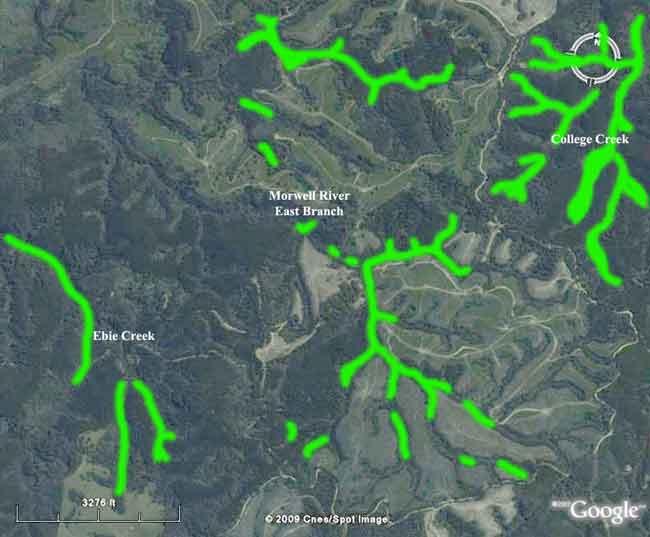
Google Earth Image of Morwell
River East Branch, highlighting cool temperate rainforest (in green).
Rainforest buffer destruction on a catchment scale. All of the logging
of rainforest buffers in this image has occurred post FSC certification.
Morwell River East Branch Rainforest is regionally significant, College
Creek is a site of state significance for its rainforest attributes
and national conservation significance for its conservation attributes.
This kind of practice would not be allowed elsewhere in Victoria.
Rainforest and Cool Temperate
Rainforests of Victoria
"Rainforest is protected
throughout Public Land in Victoria, either by inclusion in the formal
conservation reserve system or by a range of measures, including zoning
and prescriptions.
Sites of significance
have been delineated, described and rated (Peel 1999, Cameron 1990)
and contribute towards he design of Reserve systems within all Forest
Management Area Plans. These have been assessed by considering the following
attributes: ecological integrity and viability, floristic composition,
biogeography, and representation. They have been ranked according to
their National, State, Regional or Local significance. Core zones which
may contain Rainforest stands, have been identified. These have been
updated in the Strzelecki Ranges by Hill and Timewell 2001.
Areas of rainforest MUST be defined and a
strategy for their management MUST be included as part of planning
for conservation of flora and fauna in Forest Management Plans and /
relevent prescriptions.
In the absence of detailed strategies within an approved
Forest Management Plan, which address Regional characteristics, the
following minimum prescriptions will apply.
*Stands of lesser significance 40m buffers
* Stands >20% Nothofagus buffers of 60m
*Sites containing Nationally significant Rainforest,
generally subcatchment protection.
Forest Management Plans have been prepared
for Otways, East Gippsland, Central Highlands and Gippsland.
In the Strzelecki Ranges, Rainforest occurs
on Public Land licensed to Hancock Victorian Plantations. HVP is working
with Department of Sustainability and Environment, Trust for Nature
and community groups to develop and implement a management framework
to ensure the long-term protection of rainforest on their land and to
establish habitat links on adjoining land."
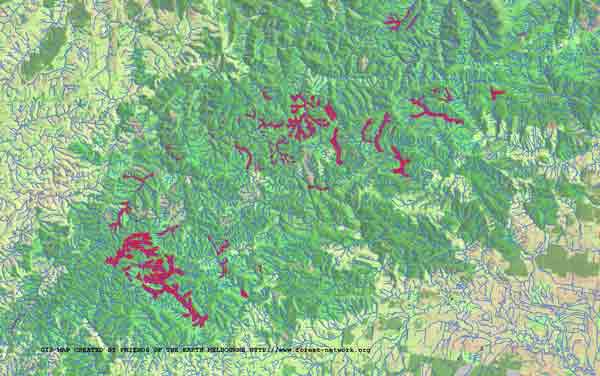
Strzelecki Cool Temperate
Rainforest (in red)
Click
here for: Rainforest
Hotspots Jeeralang Creek East
Branch Morwell River
East Branch
Peer Review of Proposed Rainforest
Best Management Practice (October 2005/April 2006)
Smartwood/FSC Audit Results 2004 - 2005
- 2006 - 2007
Cores and Links Reserve and Rainforest Map
Private land and Cool Temperate Rainforest
Public Lands Native
Forest
Private land native forest and all plantations
Forest Management plan for Gippsland
Conservation Guideline Cool Temperate Rainforest
and Warm Temperate Rainforest
Working definition of rainforest Ecological Vegetation
Classes in Gippsland
Rainforest Indicator Species
SUMMARY - PEER REVIEW OF PROPOSED RAINFOREST
BEST MANAGEMENT PRACTICE OCTOBER 2005
Draft Flora and Fauna Action Statements
Slender Tree-fern Cyathea cunninghamii (including
references to skirted Tree-fern Cyathea X marcescens)
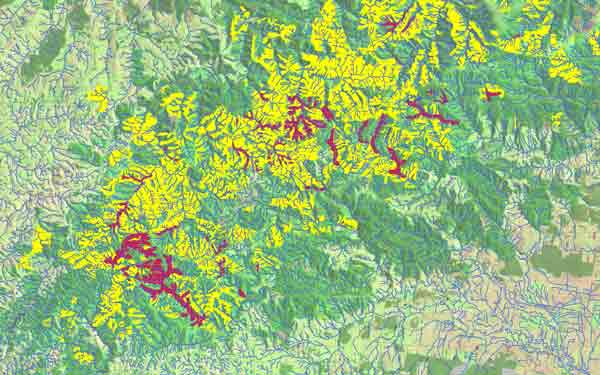
Strzelecki Cool Temperate
Rainforest (Red). Approximate Hardwood Reforestation in Yellow.
Smartwood/FSC Audit Results
2004 Audits

March 2005: FSC auditors, working
for Smartwood about to enter cool temperate rainforest at Morwell River
East Branch. Photo & Caption: Hancock Watch
CAR#1: CAR1-2004 Reference Standard#:6.1, 9.1
For full copy of audit see
here
Applicable finding from Monitoring Report (June 2004): "During
the orginal assessment, SmartWood raised concerns that the then proposed
minimum buffers (e.g.40 metres) proposed for the protection of rainforest
might be inadequate. Some stakeholders and experts believe that the
new draft BMP may provide even less protection (e.g. a nominated 10
meter buffer that could be one quarter of the width required by the
Code of Forest Practices in native forests for stands of rainforest
with lesser significance, i.e less than National conservation significance).
There are also inconsistencies with the recommendations for the conservation
of rainforest identified in the Strzelecki Ranges Biodiversity Study
(a minimum of two tree heights or about 100 meters). Currently, until
the BMP is complete, HVP is actively seeking stakeholder input and consultation
on the design of buffers, though some stakeholders are increasingly
uncomfortable with this approach - they would like to see the BMP completed
and thus the design of buffers handled completely by HVP staff, based
on technically sound guidance." (page 6)
"Ultimately, based on SmartWood experience worldwide, it is likely
that a strict quantitative buffer (e.g. 100 meters) will not be the
appropriate solution; rather a technical solution that varies the buffer,
possibly based on forest composition and structure, slope or other variables.
These issues are of such importance and urgency that they heighten the
importance of completing the BMP for rainforest management as soon as
possible, but at the same time ensuring that a high quality, technically
sound product results, with strong independent peer review and stakeholder
input. Until this BMP process is completed, on-the-ground management
activities by HVP are expected to take a strongly "precautionary"
approach, erring on the side of larger, rather than smaller, buffers.
Also HVP should continue to seek stakeholder input for the design of
current buffers, as it has done recently, though other mechanisms should
be explored as some stakeholders may not be able to continue to provide
such inputs under the current system". (Page 6)
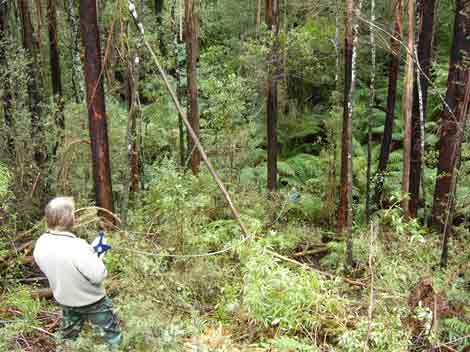
September 2004: Strzelecki
Ranges North Face (Parish of Jumbuk - Crown Leasehold): Morwell River
East Branch Rainforest off Lawless Track. Hancock have logged within
15 metres of cool temperate rainforest at this site. The person holding
the tape in the gully is standing next to a Myrtle Beech tree. Rainforest
of regional significance occurring in State Forest is granted at least
40 metre buffers. Yet Hancock at this site has granted 25 metre less
than what is warranted in State Forests. This has occurred despite Hancock
being granted FSC certification. Photo & Caption: Hancock Watch
"During the audit it was clearly noted (discussed under Criterion
9.3) that the then proposed minimum buffer of 40 meters proposed for
the protection of rainforest was inadequate. The BMP appears to have
been revised since to provide even less protection for this HCVF. The
nominated 10 metre buffer for rainforest identified by the BMP will
probably not survive any acceptable peer review. The nominated 10 metre
buffer is one quarter of the width required by the Code of Forest Practices
(in native forests) for stands of (rainforest) with lesser significance
(less than National conservation significance). It is also inconsistent
with the recommendations for the conservation of rainforest identified
in the Strzelecki Ranges Biodiversity Study (a minimum of two tree heights
or about 100 metres). (page 16)
Corrective Action Request: The Rainforest Management BMP shall be
completed by 1 March 2005 including and independent peer review and
further stakeholder input. The current accepted practice of stakeholder
involvement in boundary marking is to continue with coupes where HVP
harvests plantations adjacent to any areas of Cool or Warm Temperate
Rainforest.
Timeline for Compliance: By March 1, 2005
Audit Findings 2005

April 2005 Strzelecki Ranges
Ryton Junction - Coupe located in the Albert River catchment between
Minottis and Waack Track. Gutting of cool temperate rainforest gully.
A buffer of 20 metres had been granted at this coupe to Myrtle Beech
within this gully, effectively leaving no rainforest buffer at this
site. This site was logged during or just after the most recent audit
of Hancock's operations carried out by FSC certifier Smartwood. Photo
& Caption: Hancock Watch
Audit findings: At the time of the annual audit in March 2005 and by
the time of completion of the draft audit report on June 2005, HVP had
developed a substantial series of documents that integrate to form the
Rainforest BMP (RF BMP).
These include Rationale for the rainforest BMP, Company rainforest
policy, Procedure for management of rainforest on Company land, Operating
standard for the evaluation of conservation significance of rainforest
on Company land, and Operating standard for the protection of rainforest
on company land.
At the time of the audit, HVP had not completed the RF BMP. The primary
outstanding items required in the CAR to be met by March 1, 2005 were
independent peer review and further stakeholder input. At the current
audit, the draft RF BMP available during the SW monitoring audit from
June 2004 had been revised, but was not completed in a form ready for
external peer review. The draft had been reviewed internally by some
HVP staff and by a company director who is also a professor at the University
of Melbourne with expertise in rainforest identification.
At the time of the annual audit, HVP anticipated that the document
required some additional revisions but was very close to being ready
for external peer review. One potential peer reviewer had been contacted.
A second peer reviewer had been identified, but had not been contacted.
The potential date for completion of peer review was unclear and depended
very much on the availability and time requirements of suitable peer
reviewers to review it. In May 2005, HVP advised the audit team that
the document had been sent to one of the identified peer reviewers but
the company had not received any comments. The second peer reviewer
could not complete a review in a reasonable time and HVP was searching
for another potential reviewer. Further communications with HVP indicated
that the company was steadily progressing and seriously engaged in efforts
to contract suitable peer reviewers with the requisite ecological background
and availability to complete the peer review in a timely manner.
At the time of the annual audit, written terms of reference for peer
review were not given to the audit team and the auditors were left in
doubt as to the scope and methodology to the peer review. Since the
audit, HVP have shared with SW staff the letters being sent to potential
peer reviewers. These letters were not a formal TOR and would benefit
from being more complete and explicit in defining the brief for the
peer reviewer.
At the time of the audit, HVP had not made clear plans for how it would
go about "further stakeholder input" once peer review was
completed and addressed by the company. HVP did plan to take an internal
cost analysis of the results of the peer review process to the Board
for review before making any further commitments in regard to the BMP.
Overall, while the company had compiled the core documents of the RF
BMP in a draft state that would be suitable for peer review, not at
the time of the audit, but a few months afterwards, the process and
the timetable for completing the peer review were not clear to the audit
team during their inspection. Subsequent communications indicated that
the timetable appeared to be on the order of at least six months after
March 1.
In addition, during the annual audit, the state government indicated
its intention to release a draft "Faunal and Flora Action Statement"
on cool temperate rainforests of Victoria for public comment, which
HVP receive on May 12, 2005. In May 2005, HVP advised the audit team
that they had received a first draft of three Action Statements related
to cool temperate rainforest and were reviewing those document to see
how they would affect the HVP BMP.
The second requirement of the CAR was that "the current accepted
practice of stakeholder involvement in boundary marking is to continue".
The practice of including a stakeholder in boundary marking only happened
in one coupe and stopped soon after the audit in June 2004 when the
individual involved no longer wished to participate. No stakeholders
have participated in any boundary marking since that time and HVP has
not found a replacement person or sought to establish an alternative
procedure in the interim while the RF BMP remains unfinished.
Representatives of the shires told the audit team that the width of
rainforest buffers is a highly contentious public issue, but that HVP
has not sought public input. HVP stated that the company would welcome
such input provided that the shires referred enquiries directly to forest
managers who could coordinate safe visits to coupes. The audit team
considered the lack of stakeholder involvement in boundary marking a
serious breach of the CAR. However, there are stakeholders who communicated
to SmartWood in the past that it was not feasible or realistic to expect
stakeholder involvement in coupe layout.
It is the opinion of SmartWood that the process of finalizing the RF
BMP would be the best means to resolve these issues, even though the
company should remain open to stakeholder involvement in RF boundary
issues in coupes, should it be requested, provided it was done in a
safety-conscious manner.
Since the last audit, HVP has established RF boundaries based on the
existing internal policy and procedures, which the team understands
provide for 20 meters from the defined edge of the rainforest. The auditors
visited one coupe where it was clearly precisely 20 meters but where
trees had been felled into and removed from that 20 metre buffer causing
some damage to the buffer and to rainforest trees. HVP representatives
told the audit team that numerous other coupes are laid out with similar
20 metre buffers.
This is not consistent with the comments of the SW auditors in the
June 2004 Monitoring Audit Report. That report states "Until this
BMP process is completed, on-the-ground management activities by HVP
are expected to take a strongly "precautionary" approach,
erring on the side of larger, rather than smaller, buffers" and
that a proposed minimum buffer of 40 metres proposed for the protection
of rainforest was inadequate". Certainly, a number of differences
remain unresolved between independent experts and stakeholders on one
hand, and the company on the other, regarding what is to be considered
appropriate buffer width.
For three reasons: 1) an unfinshed RF BMP and external peer and public
review process, 2) the discontinuation of stakeholder participation
in boundary marking, and 3) current boundaries that are much less than
40 metres - the team concludes that HVP has not met the requirements
of this CAR.
The audit team concludes that there is a major non-compliance with
the requirements of the CAR. In these circumstances, FSC requires that
a Major CAR with a deadline of 3 months be imposed. In the audit team's
opinion, a 3 month deadline to complete a BMP following peer review
and further stakeholder input that includes appropriate buffer widths
is impossible to meet.
SmartWood proposes a MAJOR CAR to require completion of the BMP with
peer review and external public review, including review of proposed
buffer widths, by the end of 2005.
The assessment team proposed a MAJOR CAR to require HVP to immediately
do either:
- Cease operations in all coupes that are adjacent to rainforest; or
- Put in place a minimum two tree height (100 metre) buffer on all
rainforest sites where active operations continue while the BMP is being
completed.
In review of this proposed CAR, SmartWood disagreed with the team's
suggestion to impose a more prescriptive CAR to address the original,
yet unmet, CAR 1/2004. As this original CAR was clearly justified and
defined to meet an identified nonconformance, then SmartWood procedure
would be for the unmet CAR to have been classified as "OPEN"
and then to raise the noncompliance to a Major CAR with 3 month, or
in exceptions, 6 month timeline to meet the main elements of CAR 1/2004.
Status: The requirements of the CAR had not been met. One MAJOR CAR
was imposed.
Follow-up Action: MAJOR CAR 9-2005 By the end of 2005, HVP shall
complete the Rainforest BMP with peer review and external public review,
including review of proposed buffer widths, and be implementing the
BMP.
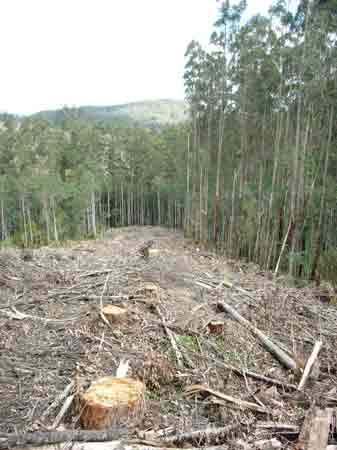
September 2005 - Strzelecki
Ranges: Morwell River East Branch. Allotment 57 Parish of Wonyip. Ex
Australian Paper Plantations Leasehold, which Hancock purchased the
logging rights for in 2001. The southern portion of this logging coupe,
logged in June/July 2005 has rainforest buffers of 15 metres. This could
well be the worst case of rainforest mismanagement in Victoria and the
operation has been certified by the Forest Stewardship Council!!! Much
of this coupe should never have been logged at all. Photo
& Caption: Hancock Watch
2006 Smartwood Audit (August
22, 2006)
Audit Findings:
Following the 2005 audit, HVP selected and engaged two
experts to review the companies' draft Rainforest BMP, including the
proposed widths of buffers. The review was completed and was submitted
to the Company in October 2005. It is a lengthy and very detailed review
that addresses many considerations and issues related to the management
of cool and warm temperate rainforest in HVP holdings. The audit team
recognizes that HVP undertook this review in a very significant way
and sought out two respected experts in this field. It is clearly an
expert review, rather than a peer review. HVP provided substantial resources
and assistance for the reviewers and they received a very thorough,
well-documented and well-reasoned 32 page report in return. The fundamental
conclusion of the two experts is that the buffers in the draft BMP for
both cool and warm temperate rainforest are "inadequate",
particularly where, as in FSC Principle 9, a precautionary approach
is required.
HVP responded to the review report in early November
2005 by sending the reviewers an annotated version of the report containing
a substantial number of points where HVP disagreed with the report.
At the time of the audit in March 2006, HVP provided the audit team
with an expanded list of points, but these additional points had not
been sent to the two expert reviewers. Since the HVP response in November,
there has been no other communication between HVP and the experts and
the draft BMP has not been completed or revised.
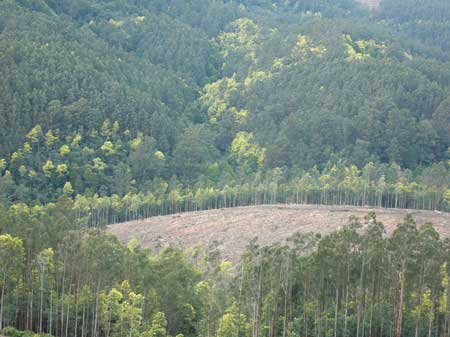
September 2006: Hancock still
leaving only 20 metre rainforest buffers atSmiths Creek.
The audit team reviewed the experts' report and the
HVP response and interviewed both experts and the HVP staff who were
directly involved. The two experts told the team that they consider
their report to stand on its merits. They acknowledge some of the points
raised by HVP but dispute others, and do not feel that any of the points
change the fundamental conclusion of the report regarding the width
of rainforest buffers. HVP told the team that they would like the expert
report to be revised to address their disagreements but acknowledge
they have not pursued this request since November. The team concluded
that while there are disagreements over some points of detail in the
review, HVP has not disputed the major conclusion of the review that
the existing BMP is inadequate to meet the requirements of Principle
9 of the FSC Standard.
Despite the conclusions of the expert review, HVP has
taken no action to revise and complete the BMP. They provided the audit
team with a 5-page outline of the company response to the expert review,
but it does not appear that any of the proposed responses have been
undertaken and the responses do not include revisions to the buffer
widths or acknowledge the conclusion that they are "inadequate".
HVP has also not sought any outside public review of the draft BMP,
as required by the MAJOR CAR, and has also not sought any outside public
review of the draft BMP, as required by the MAJOR CAR, and has not made
the report of the expert reviewers, or HVP's proposed response, available
to anyone outside the company. No external public review has been initiated
or completed at the time of the audit.
The team notes that HVP has also not taken any actions
to contact the two experts to follow up on their initial response in
November 2005. The rainforest BMP remains in the same draft form it
was at the time of the 2005 annual audit.
Finally, HVP is continuing to apply the same, or in
some cases narrower, buffer widths as in 2002 and 2004 when the original
SmartWood assessment report and the monitoring audit described those
buffers as "inadequate" and imposed CAR-2004 to establish
a process to determine adequate buffer widths. That CAR was not met
in 2005 and led to MAJOR CAR 9-2005 being imposed then.
The team concludes that for the three reasons above
- failure to complete the BMP, failure to engage in external public
review, and failure to implement revised buffer widths for rainforest
when the expert review describes the current widths as "inadequate"
- HVP has not met the requirement of the MAJOR CAR. Essentially, from
an auditing point of view, this is where the matter finishes. Guidance
to auditors from FSC and SmartWood states that a MAJOR CAR must be closed
out or the certificate will be suspended. In this case, the team concludes
that the MAJOR CAR is not closed and the failure to meet it is significant.
The team does not accept that there are major extenuating circumstances
that contributed to the delay in responding to the expert review which
was completed in October 2005. Those delays, since October 2005, were
internal within HVP. SmartWood and FSC policy therefore requires that,
until the BMP meets the requirements of Principle 9, the Company's continuing
certification should be suspended.

December 2006: Chainsawed Myrtle
Beech - Morwell River East Branch
The Company makes the case that this CAR cannot be considered
in isolation. Application of the BMP has serious implications to the
Company's resource availability in the Strzelecki area of its operations
because many of its plantation stands are contiguous with cool temperate
rainforest. For example, part of the Company's resource (the 'Cores
and Links') has been under a voluntary moratorium on harvesting because
of these associated values. Recent modelling of woodflows from the whole
GRP resource has shown that future contracted commitments cannot be
met without harvesting of plantation stands within the Cores and Links.
While the audit team accepts this connection, the presentation on resource
availability made to the audit team did not demonstrate that buffer
width on rainforest was a 'go' or 'no go' variable in meeting commitments.
In fact the modelling demonstrated that the Company would have to implement
both the exisiting (inadequate) BMP and harvest almost all the plantation
in the Cores and Links to meet its contracted commitments.Thus, the
shortfall and Cores and Links situation does not give the Company any
reasonable excuse to avoid its commitment to deal with the expert review
of the BMP. The only way out of the resource impasse would be to find
alternative sources for woodflows so that the resource can meet commitments
when the BMP is modified to meet the requirements of the expert review.
In addition, the company is concerned that a Draft Action
Statement on Temperate Rainforest is under public review and it does
not want to take action in advance of the finalization of that Action
Statement. The audit team does not accept that this is a reason to delay
implementation of provisions to meet FSC requirements in Principle 9.
Following the field audit, further information and evidence
was provided to SmartWood that resulted in a determination that this
MAJOR CAR had technically been met, however due to the poor wording
of the CAR the intent has not been met. Thus, this CAR is closed out
and a new MAJOR CAR2-2006 has been added that will be audited in February
2006 for completion. HVP has been advised that failure to meet the MAJOR
CAR within that time frame will result in suspension of their certificate
based on requirements of FSC.
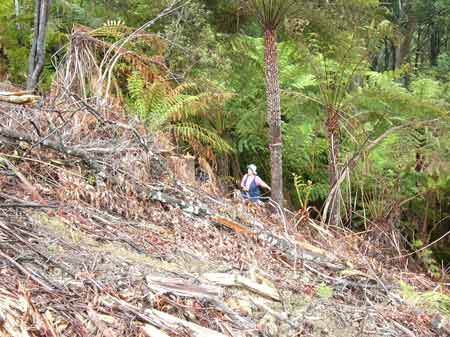
February 2007: Rainforest indicator
species found within mere metres of cut stumps - Morwell River catchment.
Status Closed:
Follow-up Action: MAJOR CAR2-2006. Within five months,
HVP shall demonstrate the following:
*A technically rigorous and thorough revision of
the current Rainforest BMP has been completed; this revision should
incorporate the specific recommendations of the peer review and other
technically sound inputs gathered through public review, and, where
applicable, a clear rationale as to why specific recommendations proposed
by peer review or other inputs have not been accepted by HVP;
*A revised BMP is provided to all HVP staff and contractors
involved in their implementation;
*Full implementation of the revised BMP has formally
started; and,
*A specific monitoring programme related to the Rainforest
BMP is in place that will be able to provide systematic information
on HVP performance in attaining Rainforest BMP conformance.
Observation 2-2006: The team recommends that HVP
do either or both of:
*finding alternative sources of wood flows or alternative
treatment regimes so that the resource can meet commitments when the
BMP is modified to meet the requirements of the expert review; or
*approaching the company needing supply from the
Strzelecki area to determine if there is any possibility of restructuring
the current supply agreement based on results of the current models.
2007 Smartwood Audit (26 November 2007)
p10-13 Assertions about the Heads of Agreement for
the Cores and Links, inadequate buffers along coll temperate rainforest
and breaches in the Strzeleckis
During the audit, several stakeholders raised concersn
about the Heads of Agreement (HoA) in regards to inadequate buffers
along Cool Temperate Rainforest (CTR) and breaches of the HoA from two
harvested coupes within the 'Harvest Area'. SW accepts that the HoA
is a major development from the previous annual audits, and the rationale
behind the proposal has been summarised in the 2006 annual audit. This
annual audit focused on evaluating HVP's compliance with Corrective
Action Requests that SW has imposed in past audits, and evaluating HVP's
compliance with the FSC standard (as set out in the SW standards for
Australia). SW will investigate correspondence and consider matters
in regards to the HoA, as the outcome of the HoA is likely to have a
significant bearing on issues that are important to HVP's FSC certification
i.e protected areas, High Conservation Value Forests (see discussion
of Principle 9 below), and rainforest buffers. However, the audit team
considers that much of the discussion and controversy that the HoA is
generating is between the parties to the agreement, and not directly
related to the FSC standards. Therefore this annual audit report does
not provide any findings about any concerns for the process of completing
the Heads of Agreement.
Some specific issues raised by stakeholders in regard
to the HoA relate to harvesting within Radburn Road and Grey Gum Track
2. The audit team visited both of these coupes to investigate the alleged
breaches and also interviewed HVP staff in regards to these matters.
The HoA sets out specific arrangements and agreements including harvesting
regimes, minimum buffer requirements for mapped CTR, consultation etc,
in order to establish Harvest Areas and Reserve Areas and to harvest
within Custodial Land and Harvest Areas (p3 and 4, HoA).
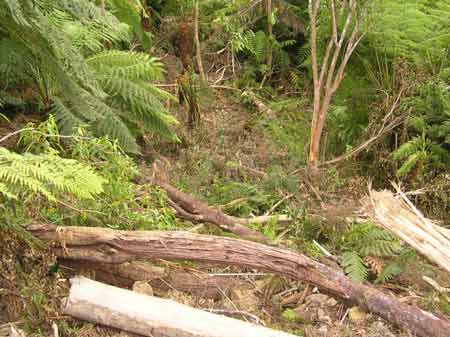
Rainforest Gully off Radburn
Road Jan 07: Hancock is redefining rainforest out of existence in order
to log all eucalypt buffers.
At Radburn Road, stakeholders alleged that part of the
Cool Temperate Rainforest (CTR) buffer in the coupe, which the HoA states
should be a minimum of 60 meters, had been harvested. However, based
on discussions with HVP their interpretation of the situation was that
the buffer width is based on the Company's CTR Best Management Plan
(BMP), which is 30 metres. As was evident from this example there appears
to be a misunderstanding and/or disagreement between what is or isn't
CTR, and what buffer width is or isn't applied to unmapped CTR. If CTR
is identified by HVP staff, but not shown on the mapped attached to
the HoA, then HVP are using the buffer width stated in the Company's
CTR BMP, rather than the HoA. Contrary to this, the stakeholders believe
that any CTR remnants (regardless of 'mapped' status) in the HoA area
should be afforded a minimum of a 60 meter buffer. It should be noted
that is was agreed by all parties, that where CTR in the Heads of Agreement
occurs on the ground, a 60 meter buffer would be applied.
The audit team examined one location within this coupe
where rainforest was present, and the buffer was greater than the buffer
stipulated in the Company's CTR BMP, but not as wide as the HoA minimum
buffer width. However, the investigation of one site is not considered
a sufficient sampel size and therefore, no conclusions can be drawn
from this examination.
At Grey Gum Track 2 and adjacent land, it was alleged
that known (previously mapped) areas of CTR had been removed from the
mapped attached to the HoA, HVP maps and coupe plans, and therefore
areas of CTR buffer were being harvested and CTR was not being afforded
the protection agreed to in the HoA. However, based on discussions with
HVP staff their interpretation of the situation was that the vegetation
of the land was not CTR, based on ground-truthing by their staff and
consultants, and therefore some of the previously mapped CTR areas had
been removed. Further, HVP susggested that one of the mapped CTR polygons
was the result of a mapping eroor from previous data transfer. Once
again it was evident from this example that there appears to be a misunderstanding
and/or disagreement between what is or isn't CTR.
The defintiion of what is or isn't CTR and where the
CTR boundary lies in relation to other forest communities is not a recent
contentious point. In the past, on public land, similar issues have
also been expressed. In recognition of this the 'differential species'
technique has been devised by the State Government's CTR expert, which
aims to eliminate any doubt in CTR EVC identification and boundary locations.
Both HVP and stakeholders have participated in CTR training in the Strzeleckis
(on some occasions both parties were in attendance), which was undertaken
by the CTR expert. Three important modifications were expressed during
training, along with the standard differential species technique. All
are to be considered when applying the differential species' technique
for use in the Strzeleckis, in comparison to other CTR remnants across
the State.
These modifications, which were developed to assist
with the definition of CTR in the Strzelecki, include:
1) the requirement for a number of CTR individuals or
a population of a certain species to be present i.e. not just an individual
of a certain species;
2) the earliest life forms i.e. seedlings are not included;
and,
3) the presence/absence of CTR cannot be determined
at recently distrurbed sites and/or grossly modified sites i.e. after
a recent fire or a recent gap in the canopy.
Further, several species were added or removed from
the species lists for CTR and for other forest communities, in order
to 'fine tune' the technique for the Strzelecki.
All parties need to be abreast of these modifications
and to apply them in a standard manner. Based on an interview with the
State Government CTR expert, if they applied as instructed during training,
then there should be no discrepancies between any parties for CTR EVC
identification and locations of boundaries.
The audit team examined one location within Grey Gums
Track 2 where unmapped rainforest was present, and the buffer was greater
than the buffer stipulated in the Company's CTR BMP, but not as wide
as the HoA minimum buffer width. However, the investigation of one site
is not considered a sufficient sample size and therefore no conclusions
can be drawn from this examination. It should also be noted that mapped
CTR was identified on the harvest plan for Grey Gum Track 2, and the
site diary notes that 60 meter CTR buffers were marked in the field.
Although the audit team did not examine all the CTR buffers, the site
diary does indicate early on that HVP checked the CTR buffere with the
Latrobe Shire and they were 'happy'.
In summary, based on submissions to Smartwood during
the audit, it is apparent that there are still some significant misunderstandings
and disagreements among the parties about details related to the application
of the provisions of the HoA for buffers along Cool Temperate Rainforest.
This is not unexpected in a draft agreement but will need to be worked
out between the parties in the coming months, and will be reviewed in
the next annual audit.
Observation 4/07: The audit team recommends that
HVP consult with all stakeholders associated with the HoA, prior to
removing any mapped CTR from maps in the future, and clearly define
potentially contentious isssues in the HoA, such as how mapped and unmapped
CTR remnants are treated.
p22 CAR 2 - 2006 Reference Standard #:9.1
Description of Non-compliance: "For three reasons:
1) an unfinished RF BMP and external peer and public review process,
2) the discontinuation of stakeholder participation
in boundary marking, and
3) current boundaries that are much less than 40
metres - the team concludes that HVP has not met the requirements of
this CAR." Annual Report, 2006.
Corrective Action Request: HVP shall demonstrate
the following:
* A technically rigorous and thorough revision of
the current Rainforest BMP has been completed; this revision should
incorporate the specific recommendations of the peer review and other
technically sound inputs gathered through public review, and, where
applicable, a clear rationale as to why specific recommendations proposed
by peer review or other inputs have not been accepted by HVP;
*A revised BMP is provided to all HVP staff and contractors
involved in their implementation;
*Full implementation of the revised BMP has formally
started; and,
*A specific monitoring programme related to the Rainforest
BMP is in place that will be able to provide systematic information
on HVP performance in attaining Rainforest BMP conformance.
Timeline for Compliance: Within five months of the
finalization of this annual audit.
Audit findings:
At the beginning of this audit, HVP gave the audit team
a revised Rainforest BMP (policy and procedures, and operating standards)
along with a Rainforest BMP rationale, a Field Determination of the
Boundary of Rainforest document, the peer review of the HVP response,
an eight page document which details how the Corrective Action Request
(CAR) has been addressed, and sveral sheets detailing the preliminary
results of the rainforest monitoring.
In regards to the first dot point of this CAR, HVP consulted
two rainforest experts in 2005 to peer review the companies' draft Rainforest
BMP. This peer review report was submitted in October of that year.
This review was a lengthy and detailed analysis of the draft Rainforest
BMP, and generally concluded that the Companies' protection measures
for rainforest were inadequate. HVP responded to the peer review in
early November 2005, and during October 2005 and April 2006 minor amendments
were made to the peer review, but the Rainforest BMP was not completed.
Thus the MAJOR CAR was imposed.
During this audit, the audit team interviewed one of
the authors of the peer review report and HVP staff involved with the
Rainforest BMP, and confirmed that no further revisions in response
to the peer review had been discussed with the authors of the peer review
since April 2006. However, HVP have now produced a revised Rainforest
BMP, which has incorporated some of the comments from the peer review
(e.g. monitoring and some buffer widths) and where HVP deemed these
comments to be inappropriate, they have produced a 'clear rationale'
(e.g measuring 30 meter buffer widths for most regional/local remnants
of rainforest, from the mid point of the ecotone and other operational
procedures). There is also evidence that several stakeholders were sent
the draft Rainforest BMP and responses were provided, although it is
stated in a document provided to the audit team that 'no information
which had not already been considered was received'. HVP also provided
evidence that approximately 40% of the Rainforest on Company land will
be buffered by a conservation reserve if the Cores and Links agreement
progresses and a further 30% of Rainforest interface with Custodial
Land.
Therefore, the first requirement of the CAR has been
met, as a revision of the Rainforest BMP has been completed and some
comments incorporated from the peer review. Where comments from the
peer reviewers have not been incorporated, a rationale has been provided.
Further, in a letter dated 16th October 2006, the revised Rainforest
BMP has been reviewed by staff (not one of the peer review authors)
from the Department of Sustainability and Environment (DSE), and HVP's
approach to the management of rainforest has been endorsed by DSE as
"being consistent with the outcomes sought in the draft Rainforest
Action Statement".
The audit team has some technical concerns with the
revised BMP. These include how buffer widths are measured (i.e. are
they measured in the horizontal plane?), how buffer widths are determined
for steep terrain and the adequacy of the buffers for some stands of
rainforest. At the time of the audit, there are no references to the
first two issues in either the BMP Rationale or the Operating Standard,
and buffer widths are still considered "inadequate" by the
experts who conducted the peer review.
These issues are particularly pertinent when considering
the 'precautionary approach' of Principle 9, and both the nature of
rainforest remnants in the Strzeleckis and the steep topography of the
Strzeleckis. Consideration of these points would also make the Company's
rainforest rationale become more aligned with rainforest management
strategies for public land, and definitions under the Application of
the Code - Plantations, as described in the Code of Forest Practice
for Timber Production, Draft for Public Comment, February (DSE 2006).
The audit team concluded that the first requirement of this MAJOR CAR
has been met but the Rainforest BMP and the requirements of Criterion
6.2 are further discussed in Appendix 111. CAR 2/07 is imposed there.
In regards to the second dot point of the CAR, the revised
Rainforest BMP has been distributed to all HVP staff, but not yet physically
to contractors. HVP provided two valid reasons for this. They wish to
progress the BMP further before distributing it to contractors and,
operationally, contractors only require the coupe plans, which are supervised
by HVP staff. During this supervision any information related to the
Rainforest BMP are relayed by HVP staff to the contractors. The team
concluded that this was sufficient to close this part of the CAR. However,
the audit team belives that the requirement to distribute the Rainforest
BMP to contractors has merit and should be undertaken in the near future.
This has been included as Observation 8/07.
In regards to the third dot point of the CAR, interviews
with HVP staff, both in Melbourne and in Gippsland, indicates that the
implementation of the revised BMP has formally started.
In regards to the fourth dot point of the CAR, the audit
team was informed by HVP staff that monitoring had begun on two coupes
with remnant CTR present. This had been undertaken in June 2006 and
February 2007. One is the Tarra-Bulga coupe and the other is Pattinson
Road coupe. Parameters being assessed include buffer disturbance/integrity
and the incidence of Myrtle Wilt, as per the recommendations of the
peer review.
In summary, the audit team does not agree with all the
suggested rationales where HVP has not accepted suggestions or comments
of the peer reviewers, and feels that the recommendations from the peer
review should be incorporated further into the BMP (including how buffer
widths are measured, how buffer widths are determined for steep terrain,
and the adequacy of buffer widths. These are discussed further in Principle
6 and CAR 2/07 is imposed there). However, it is evident that HVP have
met the key objectives of this MAJOR CAR i.e they have undertaken the
peer review, they have provided a rationale where they differ, and they
have begun a monitoring program. Therefore the audit team has concluded
MAJOR CAR 2-2006 is met and closed.
Status: Closed
See Observation 8/07
See CAR 2/07 and rationale in Criterion 6.2 in Appendix
III
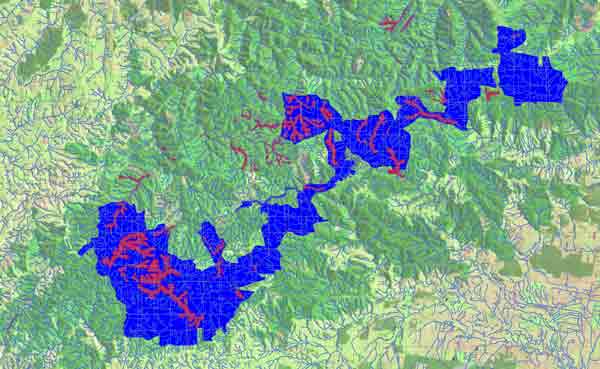
Strzelecki Rainforest and
Proposed Cores and Links Reserve
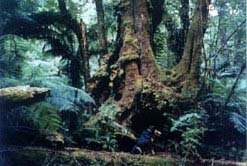 The
area between the Grand Ridge Road and Stronach's Road has been set aside
as a reserve. This area is flatter than most rainforest areas within
the Strzeleckis and the rainforest tends to extend in a wide band along
each of the tributaries. Because of the width of the rainforest, mature
and old-growth mountain ash can be found within the rainforest as well
as on the spurs. The
area between the Grand Ridge Road and Stronach's Road has been set aside
as a reserve. This area is flatter than most rainforest areas within
the Strzeleckis and the rainforest tends to extend in a wide band along
each of the tributaries. Because of the width of the rainforest, mature
and old-growth mountain ash can be found within the rainforest as well
as on the spurs.
There are many
examples of very old myrtle beech and sassafras and numerous skirted
and slender tree ferns.
The rainforest
also extends along those tributaries south of the reserve, between Stronach's
Road and Red Hill Track and between Red Hill Track and Clay Track at
the eastern headwaters of these tributaries.
 Cool Temperate Rainforest
Cool Temperate Rainforest
The terrain of
the Strzelecki State Forest had the perfect balance of altitude, rainfall
and climate to support the mighty mountain ash forests, unique to select
parts of Victoria and Tasmania. Coexisting with the wet sclerophyll
mountain ash forest and dominating the gullies were cool temperate rainforests
dominated by myrtle beech and sassafras.
Last century the
Victorian State Government resisted moves to open up this mountainous,
thickly forested region, but during the 1890's depression, the Government
was persuaded to allow selectors to lease some of this land in the highest,
most misty parts of the Strzeleckis.
Selectors attempted
to clear the forest by widespread ringbarking and burning off. The subsequent
fires which swept through the Strzeleckis in 1898 made clearing easier
and soon much of the landscape was radically altered. However, the higher
hills proved to be mediocre grazing land, and from those early days
of selection through to the 1930's, much of the higher ranges were abandoned
and reverted back to the Crown.
From the 30's
onwards, the Government has bought back more of this country, a piece
at a time, and converted many areas into plantations.
The recent change
to clear-felling and a short rotation time of 25 years, has removed
most of the remaining mountain ash forest (destroying the biodiversity
of the region and endangering the remaining native fauna). Extending
plantation right into gullies and removing buffer strips round rainforests
is also seriously endangering the last tiny pockets of rainforest.
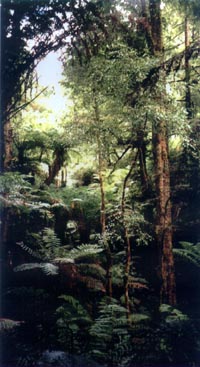
Cool Temperate
Rainforest - relic of Gondwanaland
Rainforest is
the most complex and diverse ecosystem on earth, home to more than half
of the world's plant and animal species and a valuable source of cultivated
plants, drugs and medicines.
Cool temperate
rainforest contains some of the most ancient species of plants in Australia.
Some of the smallest plants - the mosses, ferns and lichens - are amongst
the oldest survivors in the plant world.
Many of the rainforest's
ancestors grew in Antarctica, Africa, South America and New Zealand,
when these continents were joined together as one huge landmass known
as Gondwanaland. Cool temperate rainforest dates back more than 60 million
years, well before eucalypts and wattles.
Composition of
Strzelecki Rainforest
The cool temperate
rainforest in the Strzeleckis differs from that in the Otway Ranges
and East Gippsland. The rainforest in the Otway Ranges consists of Myrtle
Beech only. The rainforest in East Gippsland consists of Southern Sassafras
only. The rainforest in the Strzeleckis consists of both Myrtle Beech
and Southern Sassafras.
The understorey
is dominated by tree ferns with some Austral mulberry, Hazel Pomaderris
and Blanket leaf. The ground stratum is dominated by ferns.
In almost all
areas of rainforest there are also numerous Slender Tree Ferns and Skirted
Tree Ferns - which are included in Schedule 2 of the Flora and Fauna
Guarantee Act 1988.
Epiphytes are
abundant on the trunks of trees and tree ferns. Among the epiphytes
are two varieties of rare Tmesipteris (forked fern) Tmesipteris elongata
and Tmesipteris parva, and the more common Tmesipteris obliqua. There
are also numerous colonies of Weeping Spleenwort and Gypsy Fern.
Mosses and lichens
are also abundant.
 Extent of rainforest in the Strzelecki's
Extent of rainforest in the Strzelecki's
There are very
few areas of cool temperate rainforest left in the Strzeleckis. Only
two small areas of rainforest have been granted any official protection
at this stage. These areas are the small areas of rainforest within
the Tarra-Bulga National Park and a small section of the rainforest
in the headwaters of the Franklin and Agnes Rivers at Gunyah Gunyah.
Most other areas
of rainforest are situated within plantations. Rainforest in College
Creek and Morwell East Branch are within AMCOR plantations.
Rainforest in
the headwaters of Merriman's Creek, South Middle Creek, Jack River,
Albert River, Dingo Creek and much of the rainforest in the Agnes and
Franklin headwaters is situated in Hancock Victorian Plantations Pty.
Limited.
Threats to rainforest
in the Strzelecki's
Most of the remaining
pockets of rainforest within the Strzeleckis are situated within plantations.
These rainforests are very vulnerable to damage because of the lack
of adequate care being taken by the logging companies to protect these
forests from damage.
Buffer strips
around rainforests are not being provided and clearing is carried out
right into the edge of the rainforest.
Debris from logging
is being pushed into rainforest, causing damage to rainforest trees.
A number of logging
and access tracks have been created right on the edge of rainforest,
and at times within rainforest and across rainforest tributaries. Debris
from these tracks has been pushed into rainforest gullies causing damage
to myrtle beech and blocking the flow of the stream.
Track maintenance and reopening of tracks for logging creates more damage
and debris.
The future for
the Strzelecki rainforest
There are a number of areas within plantations where myrtle beech and
sassafras are regenerating vigorously after the rainforest has been
damaged due to logging operations. If these areas are again cleared
to extend plantations or reopen tracks, this vigorous young rainforest
will be lost. The remaining pockets of rainforest are tiny, scattered
and highly vulnerable due to their location within plantations, the
use of clear felling, short rotation time, and the push to extend plantations
to the limit. The rainforests are also increasingly vulnerable to myrtle
wilt disease. The rapid spread of myrtle wilt over the last few years
is more than enough to sound alarm bells about the viable future of
the existing mature rainforests under present management techniques.
The pockets of young, regenerating myrtle beech and sassafras could
well be the key to future survival of these rainforests and need urgent
protection.

Strzelecki Rainforest and pine plantations (brown)
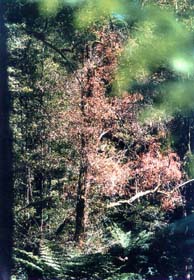 Myrtle wilt
Myrtle wilt
A major threat to the rainforest in the Strzeleckis is from myrtle wilt.
Myrtle wilt was first described in Tasmania in 1973.
In Victoria there
was no evidence of the disease during a study of Myrtle beech forests
in 1968-72, but by 1980 an aerial survey showed the disease to be well
established in the Otways. In 1991 further surveys indicated the disease
was present throughout the range of Myrtle beech forests. By 1997 trees
dying of myrtle wilt were evident in all pockets of rainforest in the
Strzeleckis.
Myrtle wilt is
endemic and is fatal for all infected Myrtle beech trees. It is dispersed
by airborne inoculum.
The incidence
of Myrtle wilt is exacerbated through wounding of root systems and tree
stems. Track construction, harvesting, windthrow and land clearing are
all factors that can increase disease incidence.
Vulnerability
to myrtle wilt may have increased due to the Greenhouse effect, increasing
the threat to the remaining rainforest.
Other Cool Temperate
Rainforest Indicator Species
Lance Water-fern (Blechnum chambersii), Leathery Shield-fern
(Rumohra adiantiformis), Austral Filmy-fern (Hymenophyllum australe),
Veined Bristle-fern (Crepidomanes venosum), Weeping Spleenwort (Asplenium
flaccidum subsp. flaccidum), Mother Spleenwort (Asplenium bulbiferum subsp.
gracillimum), Ray Water-fern (Blechnum fluviatile).
Protection
of Cool Temperate Rainforest in the Strzeleckis Bioregion.
Bergman
and Ferguson(1995) state that it is important from a planning perspective
that the processes that result in management decisions be transparent
and repeatable, not least because it will improve confidence in the
planning process. The level of description should provide the opportunity
to evaluate critically the decision making process.
Myrtle
Wilt
Until
there is general agreement on the scale of the problem of the disease
Myrtle Wilt, we need to undertake an objective cost effective scientific
assessment (aerial survey) of the Strzelecki Bioregion in order to establish:
*
The presence of the disease
*The
extent and pattern of the disease
*Whether
comparisons can be made with the Cool Temperate Rainforest in the Otways
and Central Highlands.
A
robust/rigorous methodology (to support the decision making process)
was established during the Survey and monitoring of myrtle wilt within
Cool Temperate Rainforest in Victoria, undertaken in 1991 (Cameron and
Turner 1996).
In
order to make meaningful comparisons with other regions studied, it
is important to utilise the same team, for a consistent approach and,
in particular, to eliminate operator error.
In
the interim, it would be reasonable to request than an independent rainforest
ecologist be commissioned, to determine adequate buffer widths taking
into consideration - the unique disturbance history of the Strzelecki
Bioregion plus the infectious nature and spread of the disease Myrtle
Wilt.
"As
stressed in the CSIRO interim report, given the uncertainty about the
effectiveness of buffers providing long-term protection to rainforest,
a cautious approach must be adopted. In particular the threat to Nothofagus
from Myrtle Wilt needs to be considered, as does the effect of large
trees penetrating the buffer following windthrow."
"Ideally,
measures (including the degree of buffering) to protect rainforest should
be varied regionally according to the degree of perceived risk, and
specified in the FMA plans and local prescriptions. The suggested minimum
buffer widths and/or modified strips proposed by CSIRO should be adopted
as an interim measure, but be subjected to on-going review based on
new information." (CSIRO 1996).
The
following excerpts from (Bergman and Ferguson 1995) provide an eloquent
summary of the points expressed above.
"In
the absence of relevant information from Victorian ecosystems, the best
that can be done is to infer the potential for impacts from studies
undertaken elsewhere. This approach suffers from the uncertainty that
responses in Victorian ecosystems may not be analogous to responses
observed in other forests in other environments. The unusual composition
and ecological dynamics, particularly the disturbance dynamics of Victorian
communities, provides grounds for supposing that responses to disturbances
may be unique."
The
processes at work in Victorian rainforests that may affect the conservation
status of rainforest communities include:
*Changes
in natural fire regimes.
*
The potential for increased disease incidence.
*
The potential for ecotone disturbance from site preparation burns.
*
Edge effects on ecotones and mature rainforest from windthrow.
*Changes
in microclimate.
*Weed
invasion and other floristic and faunal changes.
Some
impacts represent change from which there is no recovery.
"The
resolution of differences of scientific opinion and the implementation
of management strategies that ensure adequate protection may only be
made by the acquisition of empirical data. Until such data are acquired,
it is incumbent on planners to treat rainforest threats cautiously,
and to implement protection measures that will cope with the potential
for long-term and landscape scale impacts."
"Management
recommendations are made to mitigate the potential for adverse impacts
of management on rainforest. Research recommendations aim to provide
the information that is important for future management decisions as
quickly and efficiently as possible."
References
Burgman,
M.A., Ferguson, I.S. (September 1995) Rainforest in Victoria: a review
of the scientific basis of current and proposed protection measures.
Forest Service Technical Report 95-4 Department of Conservation and
Natural Resources, East Melbourne.
Cameron,
D.G., Turner, L.A. (September 1996) Survey and monitoring of Myrtle
Wilt within Cool Temperate Rainforest in Victoria. Flora and Fauna
Technical Report No. 145 Department of Natural Resources and Environment
Melbourne.
CSIRO
Forestry and Forest Products (November 1996) Review of the Code of
Forest Practices for Timber Production. CSIRO response following
the consultation phase of the review. Prepared for the Department
of Natural Resources and Environment.
Suggested
further reading;
Hill,
A., Timewell, C., McCormick, S., Mueck, S. (2001) Strzelecki Ranges
Biodiversity Study. A consultants report prepared for the Strzelecki
Working Group. Biosis Research Pty Ltd.
Peel,
B., (January 1999) Rainforest and Cool Temperate Mixed Forests of
Victoria. Flora and Fauna Program Department of Natural Resources
and Environment East Melbourne.
Mueck,
S., (October 2002) Report for Gippsland Farm Plantations Inc. Regional
Interpretations of the Code of Forest Practices: Conservation of Flora
and Fauna, Management of Rainforest and Protection of Landscape Values.
Biosis Research Pty Ltd.
Private land and Cool Temperate Rainforest
Please note that Hancock leasehold and
private land are classed under the Code of Forest Practices as being
"private land", meaning that the Public land definition of
rainforest does not apply. We have included the public land definition
in order to show the comparison between protection granted to state
forest and private land. Note that private land protection for rainforest
is much less than that for public forests. This was probably done to
appease Amcor when the code Revision No. 2 was released in 1996. (Amcor,
at the time owned Maryvale pulp mill and also owned/leased land in catchments
containing cool temperate rainforest; most notably, Morwell River East
Branch, College Creek, Tarra River and Jeeralang Creek East Branch).
It would appear that someone lobbied very hard not to get private land
cool temperate rainforest specifics written into the Code. Now who could
that be? Hancock have inherited this history and are currently profiting
from it. (see: Morwell
River East Branch ).
Cool Temperate Rainforest Code of Practice
Code of Forest Practices for Timber Production Revision No.2 November
1996 Department of Natural Resources and Environment
Public Lands Native
Forest 2.3.7 p23
Goal: Rainforest* must be excluded from timber harvesting* and, because
rainforest communities may be particularly vulnerable to adjacent disturbance,
they should be surrounded by an appropriate buffer*.
Guidelines: - areas of rainforest must be defined, and a strategy for
their management must be included as part of planning for conservation
of flora and fauna in Forest Management Plans* and/or in the relevant
prescriptions.
The most important rainforest areas should be accorded highest protection;
- in the absence of detailed strategies within an approved Forest Management
Plan, which address regional characteristics, the following prescriptions
will apply:
(i) for stands of lesser significance – 40 m buffers, or 20 m exclusion
plus a 40 m modified harvesting strip (>40% of basal area retained,
low machine disturbance, minimal burning);
(ii) for stands where Nothofagus makes up >20% of the canopy – buffers
of 60 m, or 40 m buffer with 40 m modified harvesting zone (>40% of
basal area retained, low machine disturbance, minimal burning);
- rainforest areas must be shown on the Forest Coupe Plan* and buffers
identified in the field;
- buffers must be protected from damage caused by trees felled in adjacent
areas.
Note: These protection levels may be adjusted prior to the next Code
review depending on the results of further research into rainforest
protection.
Private land native forest and all plantations
3.2.7 Management of Rainforest p50
Goal: Rainforest* should be protected by reserving both the rainforest
and a surrounding buffer* from timber harvesting*.
Forest Management plan for Gippsland Department
of Sustainability and Environment June 2004 P19
3.4 Rainforest
Warm Temperate Rainforest, Cool Temperate Rainforest, Gallery Rainforest
and Dry Rainforest EVCs occur in Gippsland. Warm Tempeate Rainforest
is the most extensive rainforest EVC in Gippsland. It generally occurs
in the east of the region, near the Mitchell River, Tambo River and
Big Creek although stands are also found in the Strzelecki Ranges in
south Gippsland. Cool Temperate Rainforest generally occurs on the Nunniong
Plateau and Strzelecki Ranges, with isolated occurrences in the headwaters
of Freestone and Mount Useful Creeks. Gallery Rainforest and Dry Rainforest
do not occur in State forest and therefore are not discussed in this
plan A working definition for field identification of rainforest in
Gippsland is provided in Appendix 1.
Strategy for the protection of rainforest
This plan establishes a detailed rainforest protection strategy in
accordance with the Code of Forest Practices for Timber Production (the
Code). The Code requires that all rainforest and a surrounding buffer
be excluded from timber harvesting. It also provides guidelines for
rainforest protection, which include increased protection measures for
significant stands of rainforest and a consideration of regional characteristics
when developing protection strategies in Forest Management Plans. This
rainforest protection strategy is based on the protection of rainforest
in conservation reserves and in State forest through Special Protection
Zones, and Code of Forest Practices for Timber Production buffers, to
exclude timber harvesting from the rainforest and surrounding buffer.
The Special Protection Zone buffers range from 60 m to 100 m depending
on the significance of stands. A number of significant stands receive
sub-catchment protection. These buffers are considered to adequately
protect rainforest stands from increased exposure to light, temperature
and wind as a result of timber harvesting operations outside the buffer.
It is also considered to provide adequate protection against physical
disturbance from forest operations, which is relevant to minimising
the spread of Myrtle Wilt. Prevention of minimising the spread of Myrtle
Wilt is discussed in Chapter 6 – Forest Protection.
DSE has identified all major patches of rainforest within Gippsland
through a program of aerial photography and field reconnaissance. These
patches were assessed using the flowing criteria: ecological integrity
and viability, richness and diversity, rarity, representation of type,
and scientific and education value. Some of these patches were considered
to contain rainforest of regional, State or national significance. Sub-catchments
that contain the regionally, State or nationally significant rainforest
form a ‘Site of Significance for Rainforest’.
There are 29 Sites of Significance for Rainforest on public land in
Gippsland (Peel 1999) (see Appendix J). Eleven of these Sites of Significance
are entirely within conservation reserves, comprising 2 sites of national
significance, 4 sites of State significance and 5 sites of regional
significance. Eight sites of Significance for Rainforest cover both
State forest and conservation reserves; these are a national site of
significance, 2 sites of State significance, 2 sites of regional significance
and a site of local significance. The 10 Sites of Significance for Rainforest
that are entirely within State forest are 4 sites of regional significance
and 6 sites of local significance. Other stands are considered to be
locally significant. Within each Site of Significance for Rainforest
considered as being State or national importance in State forest ‘priority
areas’ identify the most important areas for rainforest conservation.
These ‘priority areas’ are ranked according to their relative importance
based on; - the size of individual rainforest stands or the highest
concentration of stands within each Site of Significance for Rainforest;
- stands with concentrations of rare or threatened flora; - areas with
identifiable management boundaries such as sub-catchment divides, roads
or topographic features.
Protection of rainforest stands in sites of national and State significance,
and stands of regional and local significance are incorporated into
the zoning scheme in line with the rainforest management guideline below.
The rainforest management guideline and Appendix J provides further
detail about the rainforest protection strategy in Gippsland. Appendix
J lists the proportion of each priority area within each public land
category for the Sites of Significance for Rainforest in Gippsland.
Conservation Guideline Cool Temperate
Rainforest and Warm Temperate Rainforest
The width of rainforest buffers varies according to the significance
of the rainforest stand and the priority area. The following minimum
buffers apply.
- Sub-catchments for those rainforest stands where the priority area
is substantially undisturbed or the conservation requirements of other
species or values are coincident with rainforest values;
- 100 m for priority 1 and 2 areas within sites of national significance;
- 60 m for priority 3 and 4 areas within sites of national significance
and for priority 1 and 2 areas within sites of State significance.
- 40 m for priority 3 and 4 areas within sites of State significance
and all sites of regional or local significance.
Chapter 6 Forest Protection P71 Myrtle Wilt
Myrtle Wilt is caused by the pathogenic hypomycete, Chalara australis.
It has been recorded in the Gippsland planning area in the Strzelecki
Ranges, however, it has not been recorded in State forest covered by
this plan. It appears to be a natural phenomenon but is a major cause
of death of Myrtle Beech in other areas. Following infection the trees
become attractive to the pinhole borer Platypus subgranosus, the presence
of which serves as a useful, early indicator of the disease (Kile 1987).
Human activity which results in artificially elevated levels of Myrtle
Wilt with Nothofagus-dominated Cool Temperate Rainforest has been listed
as a Potentially Threatening Process under the Flora and Fauna Guarantee
Act 1988.
Myrtle Wilt develops through root or stem wounds via air – or water
borne spores and through underground spread. The disease may also radically
alter stand structure and in public access areas create trees that are
hazardous for people and property. Further investigation should determine
the occurrence and appropriate management for Gippsland stands of rainforest.
Actions Investigate reports of Myrtle Wilt in State forest and, where
necessary, develop management guidelines for the control of the spread
of the fungus.
Appendix I p175 Working definition of rainforest
Ecological Vegetation Classes in Gippsland
Rainforest can be defined as follows: Rainforest is defined ecologically
as closed broadleaved forest vegetation with a more or less continuous
rainforest tree canopy of variable height, and with a characteristic
composition of species and life forms. Rainforest canopy species are
defined as shade tolerant tree species which are able to regenerate
below an undisturbed canopy, or in small canopy gaps resulting from
locally recurring minor disturbances, such as isolated windthrow or
lightning strike, which are part of the rainforest ecosystem. Such species
are not dependent on fire for their regeneration.
Rainforest Character Species
Rainforest is recognised as forest where one or more of the following
species contributes the highest proportion of foliage cover.
Cool Temperate Rainforest West/Central Gippsland
Pittosporum bicolour Banyalla
Atherosperma moschatum Sassafras
Nothofagus cunninghamii Myrtle Beech
Tasmania lanceolata Mountain Pepper
Acacia melanoxylon Blackwood
Warm Temperate Rainforest
Acacia melanoxylon Blackwood
Acmena smithii Lily Pilly
Elaeocarpus reticulatus Blue Olive Berry
Pittosporum undulatam Sweet Pittosporum
Tristaniopsis laurina Kanooka
Cissus hypoglauca Jungle Grape
Rapanea howittiana Muttonwood
Hancock Victorian Plantations Pty Ltd
PEER REVIEW OF PROPOSED RAINFOREST
BEST MANAGEMENT PRACTICE
OCTOBER 2005 1
Terry Walshe 1 and David Cameron 2
1 Centre for Excellence in Natural Resource Management,
University of Western Australia, 35 Stirling Tce, Albany, WA 6330.
2 Threatened Species and Communities Program, Department
of Sustainability and Environment, 123 Brown St, Heidelberg, VIC, 3084.
1 this version incorporates minor amendments in
response to Company comment received between October 2005 and April
2006.
EXECUTIVE SUMMARY
The brief for the conduct of this peer review requires
a critique of the BMP with particular empahasis on the Rationale and
Operating Standard for the protection of rainforest. More specifically,
the brief requests:
*Examination of the ecological basis of the Rationale,
in particular the description of the ecological processes for Cool Temperate
Rainforest and Warm Temperate Rainforest and the analysis of elements
of the risk profile.
*Comment on the strengths of weaknesses of the proposed
protection measures, in particular the extent of buffering from a risk
analysis perspective.
Central to this review is assessment of the extent to
which the Company's proposed BMP is consistent with Principle 9 of the
Forest Stewardship Council's Interim Standard for Assessing Forest Management
in Australia. Rainforests occurring on HVP lands are considered 'high
conservation value forests' under Principle 9 of the Interim Standard,
which states: Management activities in high conservation value forests
shall maintain or enhance the attributes which define such forests.
Decisions regarding high conservation value forests shall always be
considered in the context of a precautionary approach.
Although it includes no comment on the need for a precautionary
approach, the intent of Principle 9 is essentially preserved in the
goal of the Company's proposed BMP, which states: Protection measures
will be developed to manage the risk profile for rainforest on Company
land with the aim of ensuring no net loss in extent and quality
of rainforest, consistent with Victoria's Native Vegetation Framework
(emphasis added).
We saw the central task of our review to be assessment
of the internal consistency of the BMP's Rationale and protection measures
against Principle 9 and the Company's stated goal.
In general, we consider the BMP Rationale does a competent
job in identifying hazards. We are less convinced of the arguements
advanced in the Rationale regarding the magnitude of risk some of these
hazards pose, and the associated imperative to manage those risks. In
particular, we regarded the treatment of risks posed by weed invasion,
buffer disturbances and edge effects, Myrtle Wilt, and wildfire to be
deficient.
In relation to a goal of 'ensuring no net loss in extent
and quality', the proposed BMP implicitly asserts that 20m (for
locally and regionally significant rainforest) and 40m buffer widths
(for state significant rainforest) will result in:
*No net increase in the incidence of weeds
*No net attrition in the viability of rainforest species
through microclimatic stress beyond background levels
*No net increase in the incidence of Myrtle Wilt beyond
background levels
*No net increase in the risk of fire beyond background levels
Our view is that, although scientific uncertainty constrains definitive
rebuttal of these assertions, it is highly unlikely that proposed BMP
protection measures will prove consistent with the Company goal. When
a strict requirement for a precautionary approach is invoked, we consider
buffer widths proposed in the BMP to be plainly inappropriate.
We draw the following conclusions in the context of Principle 9 of
the Forest Stewardship Council's Interim Standard:
1. The Company's proposed protection measures for locally significant
Cool Temperate Rainforest fall marginally within plausible bounds of
scientific uncertainty for a goal of 'no net loss in extent and quality'.
However, where a precautionary approach is stipulated, we regard protection
measures to be inadequate.
2. If the requirement for a precautionary approach were to be relaxed,
we consider specification of performance criteria and a rigorous monitoring
program are needed in key areas of scientific uncertainty.
3. Protection measures for nationally, state and regionally significant
rainforest are inadequate.
4. The proposal of no buffer for riparian stands of warm
temperate rainforest is inadequate.
5. The field method for determining the boundary of Warm
Temperate Rainforest on Company land requires further work.
We consider the BMP could be improved through adoption
of the following recommendations: Include 'promote post-wildfire recovery'
as a goal, and provide substance to the goal through stipulation of
larger buffers around core rainforest, (e.g. at the confluence of two
second-order or higher streams).
*Include 'contribute to prevention of Myrtle Wilt epidemic'
as a goal, and provide substance to the goal through stipulation of
larger buffers on all non-linear (>40m wide) Nothofagus-dominated
stands.
*Monitor performance criteria describing thresholds for
-Weed invasion
-Abiotic microclimatic variables and the ecological impact
-Buffer disturbance
-The incidence of Myrtle Wilt
*Test the effectiveness of buffers as a risk management
strategy for fire by monitoring fuel loads and fuel moisture in buffers
or varying widths and varying stand age.
*Avoid exposure of more than one side of a rainforest
patch to edge effects within any 5 year period through inclusion of
a strict spatial constraint to this effect in harvesting scheduling.
Draft Flora and Fauna Action
Statements
HUMAN ACTIVITY WHICH RESULTS IN ARTIFICIALLY ELEVATED
OR EPIDEMIC LEVELS OF MYRTLE WILT WITHIN NOTHOFAGUS - DOMINATED COOL
TEMPERATE RAINFOREST
Harvesting in State Forest
Buffer Zone at least 60m in width around stands of Cool
Temperate Rainforest where Myrtle Beech makes up >20% of canopy (Strzelecki's
is a seperate case also depending on indicator species Field Manual).
Wider buffers where slopes exceed 20 degrees or other factors significantly
increase the risk of wounding.
Sites of national or state significance warrant higher
levels of protection from infection. These buffers are specified in
Forest Management Plans.
Management
* Avoid road construction and maintenance activities that
result in wounding of Myrtle Beech.
* Assess and manage weed invasion weed free areas to control
key infestation sources and vectors to prevent the establishment of
new, high threat weed species.
* Alteration to stream flows and increased siltation rates
may impact on Rainforest communities in riparian environments.
Conservation Objectives
1. To maintain/enhance the extent and condition of Rainforest
in Victoria.
2. To manage Rainforest in a way which maximises recovery
from catastrophic events such as fire and outbreaks of Myrtle Wilt.
Appendix provides a descriptin NOT a definition and has
been superceded by Cameron's Field Manual. The Strzelecki Cool Temperate
rainforest is not listed, it is still combined with the Central Highlands
Cool Temperate Rainforest. However it is still listed as Nationally
threatened.
Burgman and Ferguson quantified the edge width as a general
measurement of 100 metres.
Strzelecki Warm Temperate Rainforest highly depleted Nationally
threatened. (Peel 1999).
Slender Tree-fern Cyathea
cunninghamii (including references to skirted Tree-fern Cyathea X marcescens)
Listed under the Flora and Fauna Guarantee Act 1988
The relatively small size of Slender and Skirted Tree-fern
populations and their contraction to gullies makes them particularly
vulnerable to off-site catchment effects. The greater the level of fragmentation,
the greater its vulnerability to edge effects.
As Slender Tree-ferns are associated with Myrtle Beech
dominated communities threatened by myrtle wilt, it could experience
significant secondary impacts due to habitat change.
Weed invasion pose serious threats to this community.
with changed understorry conditions of weedy commuities which may result
in reduced light and moisture for the germination of spores.
Conservation Objectives: To ensure Slender Tree-ferns
can survive, flourish and retain its potential for evolutionary development
in the wild.
Objectives of this Action Statement: Protect, maintain
and enhance exisiting populations and their habitats. Protect existing
and potential habitat so that re-colonisation can occur. Ensure that
natural ecological processes are maintained with Slender-tree fern habitat
with a minimum of human intervention.
|

















